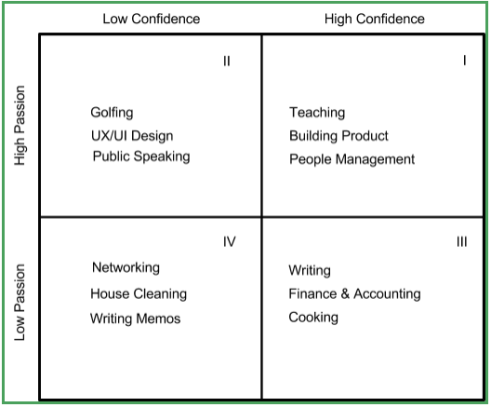Startup Stories Part 17: Figure Out Your Confidence-Passion Matrix

Here’s the 17th part of my bi-weekly column with The Star Metrobiz. Read the
original post. Hope this helps.
In August 2015, MaGIC took about 40 Malaysian entrepreneurs on a two-week e@Stanford immersion programme in Silicon Valley, in collaboration with Stanford University.
On the first day, we had the pleasure of getting Tina Seelig, who runs the Stanford Technology Ventures Program (STVP) and teaches at the d.school, to conduct a workshop on creativity and innovation, based on her new book InsightOut: Get Ideas out of Your Head and into the World.
Her class left me with such an impression that I wanted my team at MaGIC to experience what we’d learned in that session. I also wanted people to understand the difference between creativity and innovation, especially when it’s part and parcel of MaGIC’s brand name.
Tina opened by explaining the four components to the Invention Cycle. Here are my key takeaways:
Imagination: You envision something that doesn’t exist
Creativity: You apply imagination to address a challenge. This is where you figure out that there are multiple ways to solve an existing problem. Just because something is creative doesn’t necessarily mean it’s innovative.
Innovation: When you apply creative ways to solve a new problem that hasn’t been thought of before, you’re creating a new product for a new market. This is called innovation.
Entrepreneurship: Finally, entrepreneurship is where you put innovation into practice and bring ideas to fruition.
When you repeat this process, you keep inventing groundbreaking products that solve real problems.
The next segment of her class focused on a new framework to help draw out motivations behind people’s behaviour. It’s called the Passion-Confidence Matrix. The matrix gets people to categorise activities based on our degrees of passion and confidence.
In this week’s team meeting, I did an exercise with my team by asking them to write down both personal and professional activities that fit into those four quadrants with post-it notes.
Here’s how mine looks like:
The idea is that each quadrant tells you how we can improve ourselves. The challenge is for us to move into the quadrant where we feel most passionate and confident.
Here’s what each quadrant means:
1. High Confidence, High Passion: This quadrant is where you want to be spending considerable time doing, where we can leverage our strengths to bring out the best in us. We should also try to put people we hire in positions based on their skills in this quadrant, so they are most productive and less likely to be disengaged.
2. Low Confidence, High Passion: This is where you need to take action and invest more time and effort practicing and building up your confidence. In his book Outliers, Malcolm Gladwell postulates that you can be an “expert” in anything if you invest 10,000 hours doing it. For example, I’m passionate about golfing but I’m not very good at it yet, so I am committing myself to a weekly driving range session plus 10 golf lessons to eventually move this activity from QII to QI.
3. High Confidence, Low Passion: This is where you need to change your mindset and attitude. If this is something that you’re really good at doing but have lost interest in perhaps because it has become a chore, think about how you can be creative and make it more interesting or fun to do again.
For example, I know I can write relatively well but I am not super passionate about it until I forced myself to commit to a bi-weekly column. And when I see people getting value out of my articles, it reignited my passion to write more. So I’ve effectively moved an activity from QIII a step closer to QI when I saw writing with a new lens.
4. Low Confidence, Low Passion: This is where you have an excuse to delegate or outsource to someone else, unless it’s part of your job description (there’s always some 10% of your work that you absolutely dislike but have to do anyway, and you’ll just have to accept it).
For example, since I have a very front-facing role in my job, I often find networking events very tiring and no longer feel passionate doing it. So I hire others who’re really good with people and who genuinely enjoy networking with strangers, to help me pull in the right relationships.
The point is that you should spend the least amount of time here because it drains your energy and is not your best quality.
If you find the bulk of your job in this quadrant, then maybe it’s time to rethink the position.
This exercise isn’t merely to categorise activities, but to help find the motivation behind people’s behaviour. My team found this matrix to be really good at reframing the way they looked at what they liked or disliked doing and how to change their actions or attitudes to perform better and ultimately be happier in their personal and professional lives.
Ultimately, we have to recognise that this is not a static process, where things will move with time, and our motivations and passions will change over time as well.
As a leader or entrepreneur, you need to know not just what you and your team’s strengths are, but what motivates them so that you will know what you can do to help them move more activities to QI.
This will help spur the highest levels of creativity and innovation in any organisation.
Last but not least, this matrix also provides us with a way of finding purpose in what we do, and purpose can only be achieved if we’re both confident and passionate.
Column by,





Leave a comment